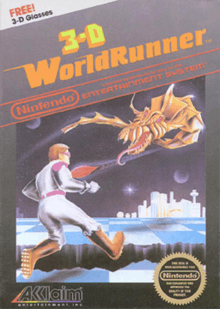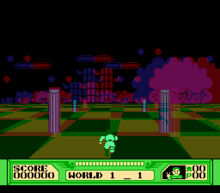The 3-D Battles of WorldRunner
| The 3-D Battles of WorldRunner | |
|---|---|
 North American cover art | |
| Developer(s) | Square |
| Publisher(s) | |
| Designer(s) | Hironobu Sakaguchi |
| Programmer(s) | Nasir Gebelli |
| Composer(s) | Nobuo Uematsu |
| Platform(s) | Family Computer Disk System, Nintendo Entertainment System |
| Release date(s) | |
| Genre(s) |
Third-Person Rail Shooter Platformer |
| Mode(s) | Single-player |
The 3-D Battles of WorldRunner (shortened to 3-D WorldRunner on the North American box art),[1] originally released in Japan as Tobidase Daisakusen (とびだせ大作戦 lit. 'Operation: Jump Out'), is a 1987 third-person rail shooter platform video game developed and published by Square for the Famicom and published by Acclaim for the Nintendo Entertainment System.[2]
Players assume the role of Jack the WorldRunner, a wild "space cowboy" on a mission to save various planets overrun by serpent-like beasts.[3] The game takes place in Solar System #517, which is being overrun by a race of aliens known as Serpentbeasts, who are led by the evil Grax.[4] As WorldRunner, the player must battle through eight planets to destroy Grax. For its time, the game was technically advanced; the game's three-dimensional scrolling effect is very similar to the linescroll effects used by Pole Position and many racing games of the day as well as the forward-scrolling effect of Sega's 1985 third-person rail shooter Space Harrier.[5] 3-D WorldRunner was an early forward-scrolling pseudo-3D third-person platform-action game where players were free to move in any forward-scrolling direction and had to leap over obstacles and chasms. It was also notable for being one of the first stereoscopic 3-D games.[2]
WorldRunner was designed by Hironobu Sakaguchi and Nasir Gebelli, and composed by Nobuo Uematsu. All would later rise to fame as core members of the team behind the popular Final Fantasy role-playing video game series.
Gameplay

WorldRunner features many elements that are typical of a forward-scrolling rail shooter game, where the player focuses on destroying or dodging onscreen enemies against a scrolling background. 3-D WorldRunner incorporates a distinct third-person view, where the camera angle is positioned behind the main character.
As Jack, players make their way through eight worlds, battling hostile alien creatures and leaping over bottomless canyons. Each world is divided into different quadrants, and the player must pass through each quadrant before the time counter on the bottom of the game screen reaches zero. In each quadrant, the player can find pillar-like columns that house power-ups, objects that are beneficial or add extra abilities to the game character. At the end of each world's last quadrant is a serpent-like creature which must be defeated to advance. A status bar at the bottom of the screen displays the player's score, the time counter, the world number, the world quadrant, the number of bonus stars (items that increase the player's score count) collected by the player, and the number of lives remaining.
Because the game is set against a constantly scrolling screen, Jack's movement cannot be stopped, but the player can speed up or slow down Jack's pace. The player is also allowed a degree of limited horizontal movement. When fighting Serpentbeasts at the end of each world, the player is capable of moving Jack freely in all directions. Jack's basic actions consist of jumping, used to dodge canyons and enemies, and firing collectible missiles of various types to destroy enemies.
In each world, the player is free to travel in any forward-moving direction. The worlds are filled with enemies that attack Jack or block his progress, but also contain items that are helpful; most of these items can be found in ancient columns spread throughout each world. Canyons, which Jack must leap over, are also present in each world, and at the end of each world is a Serpentbeast the player must defeat. The player collects various items throughout the levels which grant powers such as temporary invincibility or higher jumps, and can also find warp balloons which transport Jack to a bonus quadrant filled with super stars and items.

Part of the appeal and selling point of WorldRunner was its "3D mode",[3] and it was the first of three games by Square to feature such an option. When the 3D mode is selected, the game uses computer image processing techniques to combine images from two slightly different viewpoints into a single image, known as anaglyph images. The game was packaged with cardboard anaglyph glasses, which use red and cyan color filters to moderate the light reaching each eye to create the illusion of a three-dimensional image.[2]
Development
The main reason for the development of the game was that Square owner Masafumi Miyamoto wanted to demonstrate Gebelli's 3D programming techniques.[6] WorldRunner's soundtrack consists of eight tracks. The game was scored by Nobuo Uematsu.
Reception
Reviews for WorldRunner are generally positive. The game's graphics are widely praised as impressive, while the 3-D mode is generally considered a nice addition to a fun and simple game.[7] The game is sometimes criticized, however, as a ripoff of Sega's Space Harrier,[8] which predated WorldRunner by two years. Vito Gesualdi of Destructoid named it among the "five most notorious videogame ripoffs of all time" in 2013.[9] In a 1999 interview with NextGeneration magazine, Sakaguchi admitted that he "liked Space Harrier", but said that the main reason his team made WorldRunner was to "show off" the 3D programming techniques of Nasir Gebelli.[5] The soundtrack was criticized by Downwards Compatible, who described it as sounding like "the baby from Eraserhead".[10]
Commercially, the game was met with modest success, selling roughly 500,000 copies worldwide.[5] It is considered difficult to find a complete copy of WorldRunner today, presumably because the glasses packaged with the game ended up getting thrown away by players.[11]
Sequel
JJ: Tobidase Daisakusen Part II (ジェイ ジェイ Jei Jei) is a 1987 Japan-only followup to the game, developed and released by the same team who did the original, but as a regular cart instead of for the Disk System. JJ was one of the few games to utilize the Famicom 3D System, and was Square's last work before the inception of the popular Final Fantasy franchise.
JJ is a sort of "dark version" of the original game; it moves at a much faster pace with increased difficulty, plus a more "sinister" artstyle and use of color. The soundtrack was again composed by Nobuo Uematsu, and each track was made to match the respective track from the first game.[12]
Legacy
Jack makes an appearance in Square's Chocobo Racing as the final secret character.
See also
Notes and references
- ↑ Packaging shortens the title to 3-D WorldRunner, which is not in the game.
- 1 2 3 3-D WorldRunner at Allgame
- 1 2 3-D WorldRunner (Game Box). Acclaim Entertainment, Inc. 1987.
- ↑ 3-D WorldRunner (Game Pak Instructions). Acclaim Entertainment, Inc. 1987.
- 1 2 3 (February 1999). "Hironobu Sakaguchi: The Man Behind the Fantasies". Next Generation Magazine, vol 50.
- ↑ (February 1999). "The Man Behind the Fantasies". Next Generation, issue 50, p. 89.
- ↑ daroga (August 18, 2005). "RetroReview: The 3-D Battles of World Runner". Archived from the original on 2007-09-28. Retrieved 2006-06-09.
- ↑ "3-D WorldRunner Review for NES: A Space Harrier ripoff...but a good one. - GameFAQs". January 7, 2000. Retrieved 2010-10-22.
- ↑ Gesualdi, Vito (February 22, 2013). "Five most notorious videogame ripoffs of all time". Destructoid. Retrieved September 24, 2016.
- ↑ Lee Evans (July 9, 2012). "NES Replay: 3D World Runner". Retrieved 2012-07-10.
- ↑ NES Central Site Staff (2006). "NES Games Database: 3-D WorldRunner (1987)". Retrieved 2006-06-09.
- ↑ Michael Huang (January 1, 2006). "Nobuo Uematsu's Gameography". Retrieved 2006-05-17.
External links
- (Japanese) とびだせ大作戦 | SQUARE ENIX
- (Japanese) ジェイ ジェイ | SQUARE ENIX
- 3-D WorldRunner at MobyGames